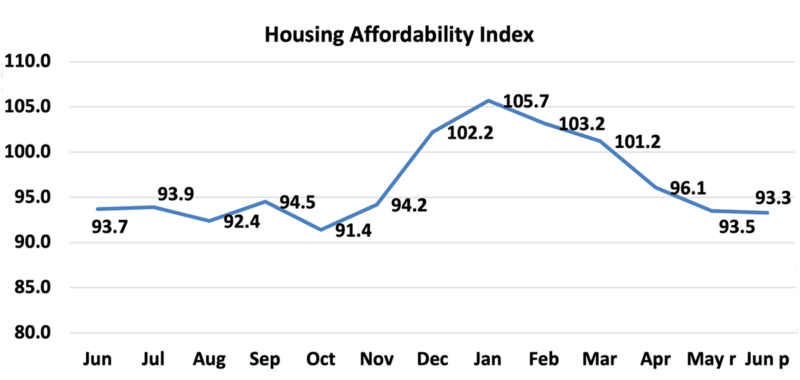At the national level, housing affordability fell modestly in June compared to the previous month, according to NAR’s Housing Affordability Index. The monthly mortgage payment increased by 1.0% compared to the prior month, while the median price of single-family homes increased by 2.4%. The monthly mortgage payment increased by $23 from last month.
Compared to one year ago, affordability fell in June as the monthly mortgage payment climbed by 6.3% and median family income rose by 5.9%. The effective 30-year fixed mortgage rate was 7.00% this June compared to 6.79% one year ago. Nationally, mortgage rates were up 21 basis points from one year ago (one percentage point equals 100 basis points). The median existing-home sales price rose 4.1% from ($432,700) compared to one year ago ($415,700).
The national index is currently below 100, which means that the typical family cannot afford to buy based on the median-priced home. An index below 100 means that a family with a median income had less than the income required to afford a median-priced home. The income required to afford a mortgage, or the qualifying income, is the income needed so that mortgage payments on a 30-year fixed mortgage loan with a 20% down payment account for 25% of family income. The most affordable region was the Midwest, with an index value of 119.2 (median family income of $100,539 with a qualifying income of $84,336). The least affordable region remained the West, where the index was 68.6 (median family income of $112,609 and the qualifying income of $164,208). The South was the second most affordable region with an index of 97.9 (median family income of $95,016 and the qualifying income of $97,008). The Northeast was the second most unaffordable region with an index of 84.3 (median family income of $115,410 with a qualifying income of $136,944).
A mortgage is affordable if the mortgage payment (principal and interest) amounts to 25% or less of the family’s income.
Housing affordability declined in two of the four regions from a year ago. The Northeast region had the biggest decline (6.5%), followed by the Midwest, which dipped 1.7%. The South experienced an incline of 2.2%, followed by the West, which rose modestly 0.9%.
Affordability rose in two four regions from last month. The West region had the biggest incline of 2.2%, followed by the South with a gain of 1.5%. The Northeast had the largest decrease of 6.9%, and the Midwest had the smallest reduction of 1.3%.
Compared to one year ago, the monthly mortgage payment rose to $2,303 from $2,166, an increase of 6.3%. A year ago, the monthly mortgage payment increased by $137. The annual mortgage payment as a percentage of income increased to 26.8% this June from 26.7% a year ago. Regionally, the West has the highest mortgage payment to income share at 36.5% of income. The Northeast had the second-highest share at 27.6%, followed by the South at 26.1%. The Midwest had the lowest mortgage payment as a percentage of income at 20.8%. Mortgage payments are not burdensome if they are no more than 25% of income.
Median home price growth has hampered affordability for potential home buyers. Mortgage rates have come down from prior months and hopefully will continue to trend in that direction. Median family incomes continue to grow. Last week the Mortgage Bankers Association reported an increase in credit availability in July. Mortgage applications also increased 6.9% from one week earlier.
Read the full data release.
The Housing Affordability Index calculation assumes a 20% down payment and a 25% qualifying ratio (principal and interest payment to income). See further details on the methodology and assumptions behind the calculation.








